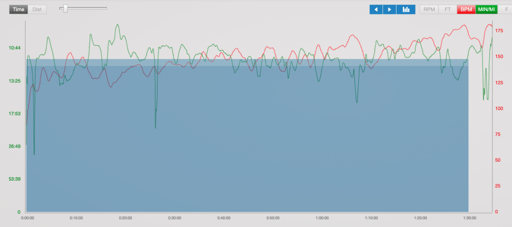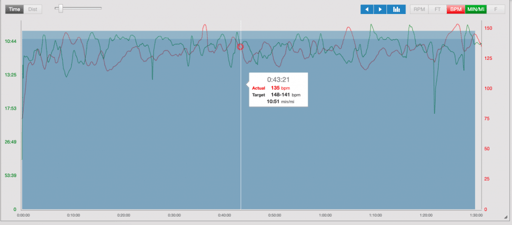How Effective is My Training Plan?

Whether we have bought, downloaded or created your plan, It can be really easy at the start of your plan to feel confident, motivated and energised by the sessions. However, a few off days and we can start to doubt the efficacy of the plan we are following.
So how do you know if your training plan is effective? The simple solution is to test it; you can do this by entering interim races, or by certain other markers of fitness. Good plans will include some regular testing every 4-6 weeks (although they might not call it a test to avoid stressing you out).
How do I test?
The best way to really test your ability to race…is to race. If your key events are short, this is relatively easy, you can do several races at your chosen distance and recovery sufficiently in a few days to begin training again. However, for longer events this is more complicated and you may need to think of alternative ways to track your fitness as the time it takes to recover from a multi-stage race or ultra event is so long it interrupts training.
What else can I test?
Functional Threshold Pace
A good standard test is to monitor your Functional Threshold Pace (the maximum pace you can maintain for up to about an hour (a bit less for running).
The simplest test to do for this (although not the easiest) is Joe Friel’s half hour time trial test; you simply warm up well and then go as hard as you can for half an hour trying to maintain a constant pace for the whole half hour. Flat terrain is best. Your average pace for that half hour is your Functional Threshold Pace. As you get fitter this should decrease (ie you get faster).
If a solo time trial really isn’t for you then a 10km running race or 20-30km organised bike time trial (depending on your bike fitness) approximate to your Functional Threshold Pace and can be used instead.
5 Minute Maximum Pace
As you maximum 5 minute pace roughly translate to you VO2Max pace (the pace at which you consume the maximum amount of oxygen in 1 minute) this is a good measure of fitness. You perform the test in exactly the same way as the Functional Threshold Test but go as hard as you can on flat terrain for 5 minutes trying to maintain a constant pace for the full five minutes. Whilst a great marker of fitness, sprinters tend to do better at this even though they may not maintain pace for the full 5 minutes.
Aerobic Fitness
Without proper equipment it can be tricky to test your aerobic threshold accurately (the pace at which your body starts using more lactate to fuel the pace). Marco and Ale (HRV4Training) have developed a way to approximate your aerobic threshold heart rate in running, but you need to be on flat even terrain for this to work effectively. There are other tools you can invest in if you wish for greater accuracy. However, arguably just as good is to have a regular loop of up to 90 minutes (it can be as little as 45) that you do at an easy conversational pace/heart rate range. As you get fitter you will notice that you are going faster at the same heart rate range, or at the same pace for a lower heart rate depending on the metric you are prioritising.
Power
As with Pace you can test your Functional Threshold Power either by using the same test as described for Pace but taking the average power or by a ramp up test or (for running) the 9/3 minute test or 6/3lap test as described by Stryd. https://support.stryd.com/hc/en-us/articles/115003989074-How-do-I-perform-a-Critical-Power-test-and-get-my-Critical-Power-and-Power-Zones-
Heart Rate Drift
A useful measure of your aerobic fitness if you have the inclination is to monitor your heart rate drift over long endurance training sessions on flat(ish) terrain. This is effectively another way of measuring your aerobic fitness (if you do the run at the right intensity). For this all you need to do is go at a constant pace (75-85% of your Functional Threshold Pace if you know it) for an hour or more and notice if your heart rate drifts up or remains steady (after your warm up). The longer it takes for your heart rate to start to climb the more endurance you have; as you do more endurance (easy conversational paced) training the longer it should take to happen. If you subscribe to TrainingPeaks Premium the Pa:Hr data in the analysis section of your workout will show you how much drift there is (anything up to 5% over the course is good).
You can see how the athlete below improved his endurance over a 90 minute run by the decrease in heart rate drift (14.2% in the first run to 3.04% in the second).


How Often should I Test?
If we assume that it generally takes 6 weeks to effect a physiological change then doing some kind of test every 6 weeks should enable you to track your data all else being equal. All else being equal means limiting the variables as much as possible. For example:-
- You have a similar amount of rest before the test.
- You do it on exactly the same terrain
- You do it at a similar time of day
- You do it on your own
- The weather is similar
- You are at a similar level of arousal
- You have eaten similar foods at similar times
- You are a similar weight
Clearly not all those items are controllable, so we have to work with the best we can get.
What are the aspects of a good off-the-shelf training plan?
- Good training plans give clear instructions about intensity and volume for each training session.
- They include weeks that are easier on a regular basis (every 3-4 weeks).
- They have some interim goals or ‘tests.’
- They describe clearly the type of event the plan is designed for including distance and climb (elevation gain).
- They give a good description of what base level of fitness is required for you to get the most out of that plan.
- They give a good description of how much disposable time you will need to complete the plan
- They give some advice about what to do if things go wrong.
- The writer is contactable so you can ask questions if you are in any doubt about how to follow the plan.
Supplementary questions.
What should I do if tests show I’m not improving/getting worse?
A one-off bad day is nothing to worry about; you could be more tired, a bit more stressed or just distracted when you do the test so you don’t manage to do it as well. If however, you consistently start to get worse/remain static it’s useful to check in with yourself. If you are getting worse you are likely to be over-training and there will be some other associated symptoms (unusual low mood/grumpiness, disturbed sleep, tiredness, strange heart rate readings (high for easy runs, or very unresponsive) increased perceived effort even for easy training, lack of motivation to train, inability to maintain usual paces/powers). You will need to rest, recover and have a rethink about your training.
If the tests show no visible improvement and you are not feeling overly stretched by any of the training, you are likely not giving yourself enough stimulation for training effect; you will need to think about increasing/changing the stimulus in some way
That being said, improvement is not linear, you will find you have some improvement, often followed by a plateau or even a decrease in fitness; this is your cue to have a few easy days to allow your body to adapt before starting training hard again.
February 8, 2022

Comments